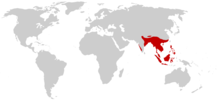| King cobra | |
|---|---|

| |
| Scientific classification | |
| Domain: | Eukaryota |
| Kingdom: | Animalia |
| Phylum: | Chordata |
| Class: | Reptilia |
| Order: | Squamata |
| Suborder: | Serpentes |
| Family: | Elapidae |
| Genus: | Ophiophagus Günther, 1864 |
| Species: | O. hannah
|
| Binomial name | |
| Ophiophagus hannah (Cantor, 1836)
| |

| |
Distribution of the king cobra
| |
| Synonyms | |
|
Genus-level:
| |
The king cobra (Ophiophagus hannah) is a species complex of snakes endemic to Asia. With an average of 3.18 to 4 m (10.4 to 13.1 ft) and a record length of 5.85 m (19.2 ft),[2] it is the world's longest venomous snake and among the heaviest. Under the genus Ophiophagus, it is not phylogenetically a true cobra despite its common name and some resemblance. Spanning from the Indian Subcontinent through Southeastern Asia to Southern China, the king cobra is widely distributed albeit not commonly seen.
Individuals have diversified colouration across its habitats, from black with white strips to unbroken brownish grey, although after taxonomic re-evaluation, it is no longer the sole member of its genus but is now a species complex; these differences in pattern and other aspects may cause the genus to be split into at least four species, spread across its large geographic range (See the #Evolution section for an overview of the current classification).[3]
It chiefly hunts other snakes, including those of its own kind, although other lizards and rodents are occasional prey items. This is the only ophidian that constructs an above-ground nest for its eggs, which are purposefully and meticulously gathered and protected by the female throughout the incubation period.[4] Typical threat display of this elapid includes neck-flap spreading, head raising, hissing and sometimes charging. Capable of striking at a considerable range and height with an immense venom yield, envenomation from this species may induce rapid onset of neurotoxic and cytotoxic symptoms, requiring prompt antivenom administration. Despite the fearsome reputation, aggression toward humans usually only arises from an individual inadvertently exposing itself or being cornered; encounters happen through chance, including negative interactions.
Threatened by habitat destruction, it has been listed as Vulnerable on the IUCN Red List since 2010. Regarded as the national reptile of India, it has an eminent position in the mythology and folk traditions of India, Bangladesh, Sri Lanka and Myanmar.
- ^ a b Stuart, B.; Wogan, G.; Grismer, L.; Auliya, M.; Inger, R.F.; Lilley, R.; Chan-Ard, T.; Thy, N.; Nguyen, T.Q.; Srinivasulu, C.; Jelić, D. (2012). "Ophiophagus hannah". IUCN Red List of Threatened Species. 2012: e.T177540A1491874. doi:10.2305/IUCN.UK.2012-1.RLTS.T177540A1491874.en. Retrieved 20 November 2021.
- ^ Cite error: The named reference
mehrtenswas invoked but never defined (see the help page). - ^ Das, Indraneil; Shankar, P. Gowri; Swamy, Priyanka; Williams, Rhiannon C.; Lalremsanga, Hmar Tlawmte; Prashanth, P.; Sahoo, Gunanidhi; Vijayakumar, S. P.; Höglund, Jacob; Shanker, Kartik; Dutta, Sushil K.; Ganesh, S. R.; Wüster, Wolfgang (16 October 2024). "Taxonomic revision of the king cobra Ophiophagus hannah (Cantor, 1836) species complex (Reptilia: Serpentes: Elapidae), with the description of two new species". European Journal of Taxonomy (961): 1–51. doi:10.5852/ejt.2024.961.2681. ISSN 2118-9773.
- ^ Lillywhite, Harvey B. (2014). How Snakes Work: Structure, Function and Behavior of the World's Snakes. New York City: Oxford University Press. p. 241. ISBN 978-0-19-538037-8.
